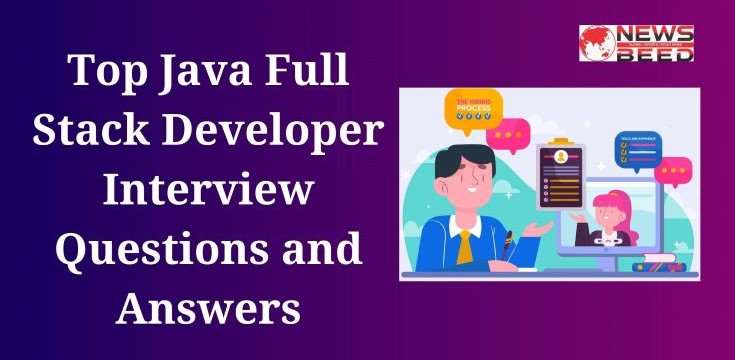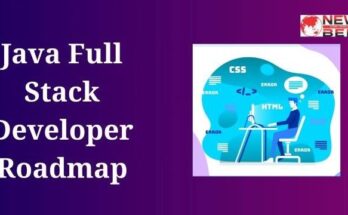Preparing for a Java Full Stack Developer interview requires a comprehensive understanding of both frontend and backend technologies, along with core Java concepts. This guide is designed to cover key questions across these areas, providing concise explanations to help you grasp the essentials.
Table of Contents
ToggleQ1. What is Full Stack Development?
Ans: Full Stack Development involves working on both the frontend and backend parts of an application. A Full Stack Developer must handle the client-side (frontend), server-side (backend), database, and sometimes even the deployment and operations aspect of an application.
Q2. Explain MVC Architecture.
Ans: MVC (Model-View-Controller) is a software design pattern for implementing user interfaces. It separates an application into three interconnected components: Model (data-related logic), View (UI logic), and Controller (interfaces between Model and View), to separate internal representations of information from the ways that information is presented to and accepted from the user.
Q3. What is the difference between JDK, JRE, and JVM?
Ans:
- JVM (Java Virtual Machine): A virtual machine that runs Java bytecodes. It provides a runtime environment for executing Java bytecode.
- JRE (Java Runtime Environment): Includes JVM and the libraries Java applications need to run.
- JDK (Java Development Kit): Contains JRE and development tools (compilers, debuggers) needed to develop Java applications.
Q4. What are the key features of Java?
Ans:
- Platform Independence: Write once, run anywhere.
- Object-Oriented: Encourages modularization and reuse of code.
- Secure: Offers a secure environment by avoiding explicit pointer and running programs inside the JVM.
- Multithreading: Supports concurrent execution of two or more parts of a program for maximum utilization of CPU.
Q5. What is Spring Boot?
Ans: Spring Boot is an open-source Java-based framework used to create a micro Service. It simplifies the bootstrapping and development of new Spring applications through convention over configuration.
Q6. Explain RESTful Web Services.
Ans: RESTful Web Services are based on REST (Representational State Transfer) architecture, which uses HTTP requests to GET, PUT, POST, and DELETE data. REST uses a stateless communication protocol, typically HTTP, and is designed around resources (identified by URIs) and the actions performed on them via methods.
Q7. What is Dependency Injection in Spring?
Ans: Dependency Injection (DI) is a design pattern used in Spring where objects are passed (injected) into another object’s constructor or through setter methods or interfaces, rather than the object creating them directly. This allows for decoupling of components and easier testing.
Q8. What is Hibernate?
Ans: Hibernate is an Object-Relational Mapping (ORM) framework for Java. It provides a framework for mapping an object-oriented domain model to a relational database, thus handling database operations and abstracting the complexity of database interactions.
Q9. How does JavaScript work?
Ans: JavaScript is a single-threaded, non-blocking, asynchronous, concurrent language. It has a call stack, an event loop, a callback queue, and other APIs in the browser or Node.js environment. JavaScript’s runtime environment processes tasks, executes functions, and handles asynchronous operations.
Q10. Explain the Document Object Model (DOM).
Ans: The DOM is a programming interface for web documents. It represents the page so that programs can change the document structure, style, and content. The DOM represents the document as a tree of nodes, enabling programming languages to interact with the page.
Q11. What are Promises in JavaScript?
Ans: Promises are objects that represent the eventual completion (or failure) of an asynchronous operation and its resulting value. A Promise is in one of these states: pending, fulfilled, or rejected.
Q12. What is React?
Ans: React is a declarative, efficient, and flexible JavaScript library for building user interfaces. It lets developers compose complex UIs from small and isolated pieces of code called “components”.
Q13. What is Angular?
Ans: Angular is a platform and framework for building client-side single-page web applications using HTML and TypeScript. It provides developers with tools and design patterns to build large-scale, high-performance web applications.
Q14. What is Node.js?
Ans: Node.js is an open-source, cross-platform, JavaScript runtime environment that executes JavaScript code outside a web browser. Node.js lets developers use JavaScript to write command-line tools and for server-side scripting.
Q15. Explain Microservices Architecture.
Ans: Microservices architecture is a method of developing software systems that focuses on building single-function modules with well-defined interfaces and operations. The architecture enables the continuous delivery/deployment of large, complex applications and allows an organization to evolve its technology stack.
Q16. What is a Docker Container?
Ans: Docker is a platform for developing, shipping, and running applications in containers. Containers package up the code, runtime, system tools, libraries, and settings of an application in a portable format. Docker containers ensure that an application works seamlessly in any environment.
Q17. What is CI/CD?
Ans: CI/CD stands for Continuous Integration and Continuous Deployment. CI is the practice of automating the integration of code changes from multiple contributors into a single software project. CD automates the delivery of applications to selected infrastructure environments.
Q18. What are WebSockets?
Ans: WebSockets provide a full-duplex communication channel over a single, long-lived connection between a client and a server. Unlike HTTP, which is stateless, WebSockets allow for real-time data transfer and communication.
Q19. Explain the concept of Single Page Applications (SPA).
Ans: SPA is a web application or website that interacts with the user by dynamically rewriting the current page rather than loading entire new pages from the server. This approach makes the application more fluid and responsive, reducing reloading and improving user experience.
Q20. What is TypeScript?
Ans: TypeScript is a superset of JavaScript that compiles to plain JavaScript. It offers optional static typing, classes, and interface. By providing stronger type checks, TypeScript allows developers to write more maintainable and scalable programs.
You May Also Read:
What is Digital Marketing in Hindi
SEO Interview Questions and Answers
Q21. How do you manage state in React?
Ans: State in React can be managed using the useState hook for function components or the setState method within class components. For global state management, solutions like Redux or Context API are used to share state across components.
Q22. What are the differences between SQL and NoSQL databases?
Ans:
- SQL (Structured Query Language) databases are relational, table-based databases that are ideal for complex queries.
- NoSQL databases are non-relational and can store data in formats such as key-value pairs, document-based, wide-column stores, or graphs. They are suitable for large sets of distributed data.
Q23. What is a JWT, and how is it used in authentication?
Ans: JWT (JSON Web Token) is a compact, URL-safe means of representing claims to be transferred between two parties. In authentication, JWTs are used to exchange user identity information between a client and a server, allowing for stateless authentication.
Q24. What is a Progressive Web App (PWA)?
Ans: PWAs are web applications that use modern web capabilities to provide a user experience similar to that of mobile apps. They aim to bring features such as working offline, push notifications, and device hardware access traditionally available only to native applications, to the web.
Q25. What is GraphQL?
Ans: GraphQL is a query language for APIs and a runtime for executing those queries by using a type system you define for your data. Unlike REST, GraphQL allows clients to request only the data they need, making it more efficient for data fetching.
Conclusion
A Java full stack developer interview will cover a wide range of topics, from basic programming concepts and core Java to advanced topics in front-end and back-end technologies, including frameworks, databases, and software development best practices. This overview touches on the essentials, but thorough preparation should include deep dives into each topic, hands-on coding exercises, and staying updated with the latest trends and technologies in the Java ecosystem.




